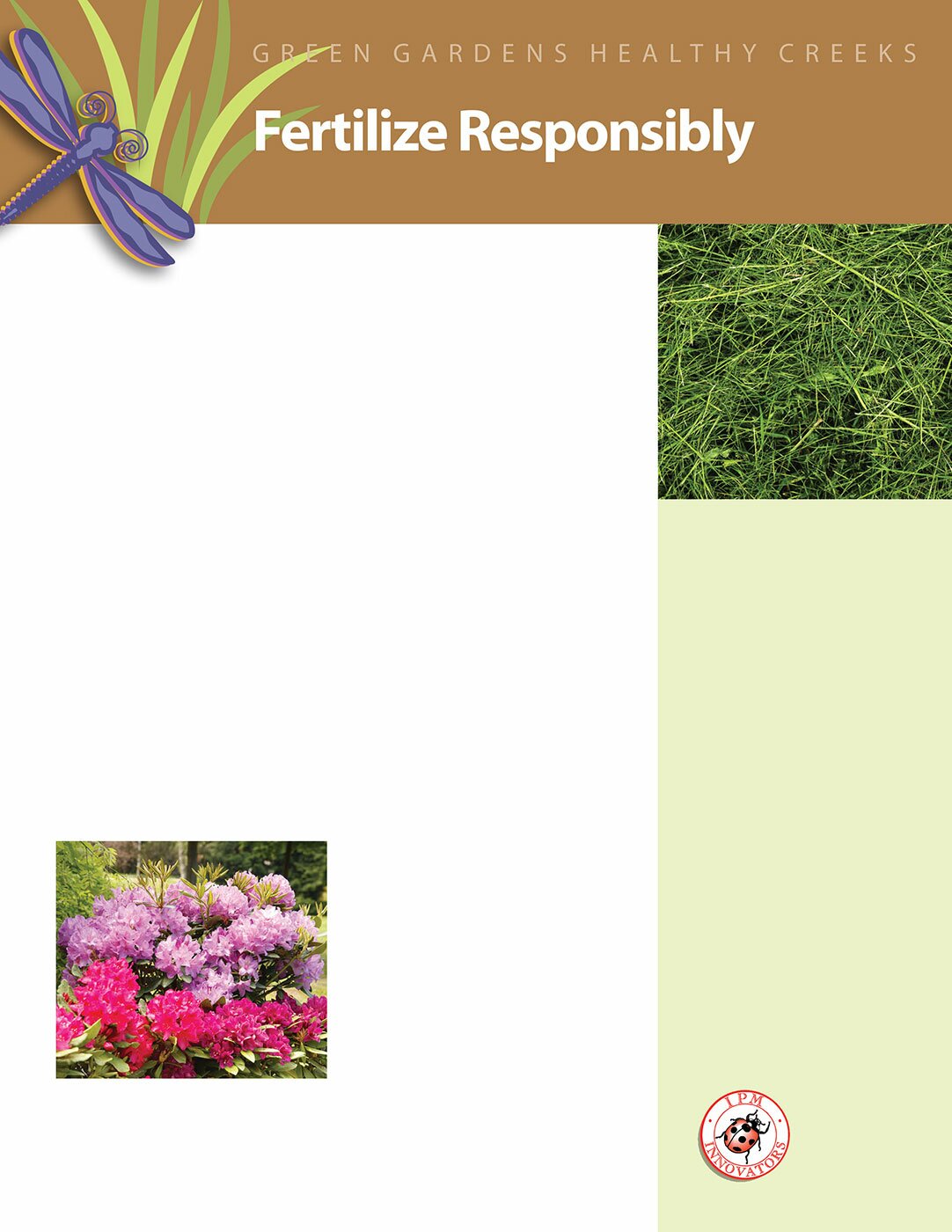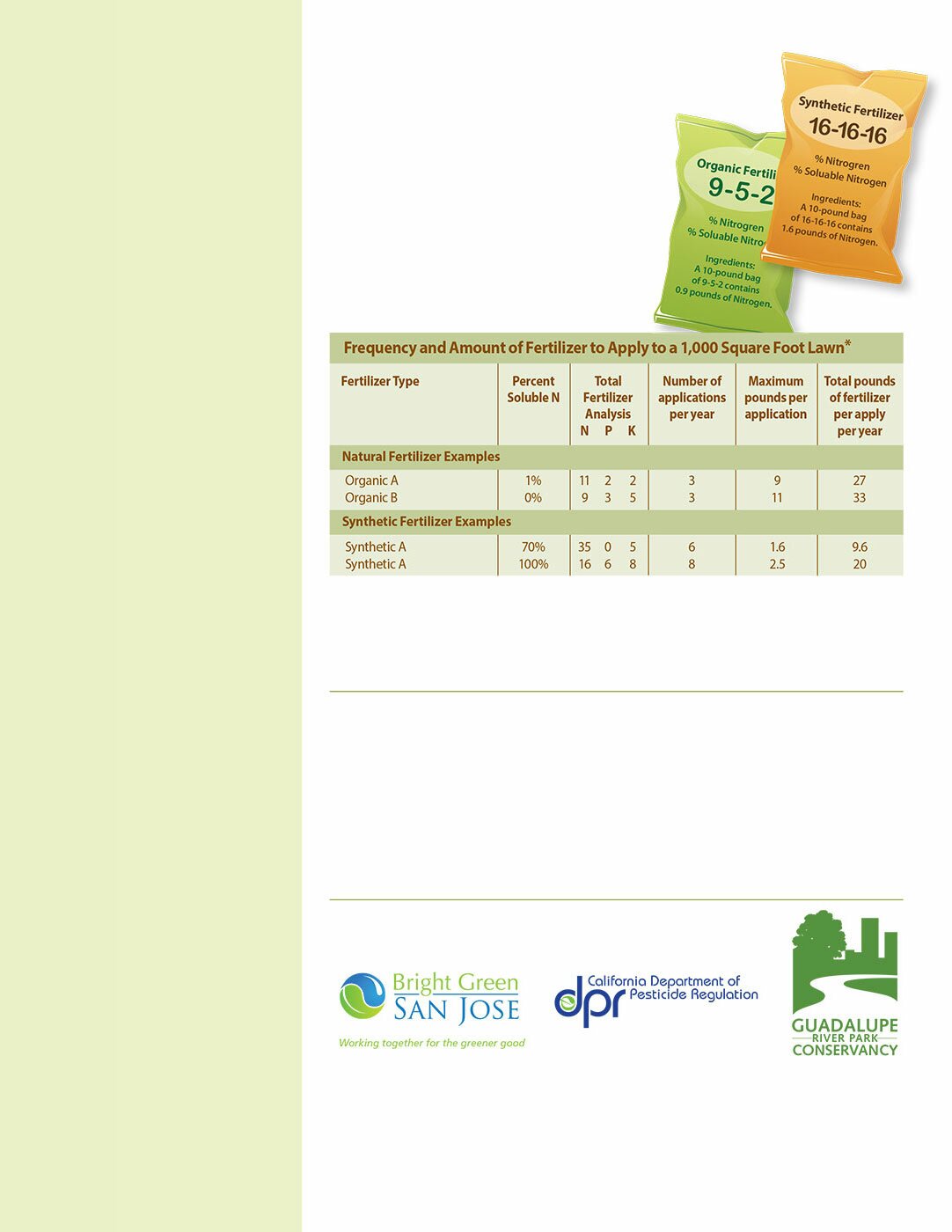
Mimic Nature
Natural landscapes fertilize themselves as soil organisms break down and recycle dropped leaves into nutrients. Your garden can use this process to maintain health and beauty without routine addition of fertilizer.
Promote natural nutrient recycling by leaving grass clippings or leaves to decompose and feed the soil. Many soil nutrient deficiencies can be remedied by applying quality compost or mulch. Proper plant selection and spacing reduces loss of soil nutrients to frequent pruning or shearing.
Fertilizers might be needed to:
- Replace nutrients removed through harvesting, mowing, or pruning when clippings are removed.
- Remedy natural deficiencies in soil types such as well-drained sandy soil.
- Aid plants not naturally adapted to the soil where they are planted.
- Achieve a desired function such as quickly establishing a privacy screen or a fruit tree, increasing vegetable yields, or promoting flower blooms before a special event.
Special fertilizer blends are available for acidloving plants such as azaleas, rhododendrons, and blueberries. Using mulch made from evergreen trees or leaves can accomplish the same soil acidifying effect over time.
Know your Soil
Fertilizers should be used only after the need has been assessed. To determine if you need fertilizers, you must know your soil. See the Start with Healthy Soil factsheet for information on how to test your soil. Ask the soil testing company for organic recommendations for improving soil fertility.
Select Fertilizers Wisely
Use a natural or organic fertilizer when needed. Organic fertilizers are made from naturally occurring minerals or from renewable, biological sources such as plants, animals, animal manures, or seaweed. Organic fertilizers are preferred because:
- They contain a wide range of macro and micronutrients.
- The nutrients are in a form that feeds soil life and improves soil structure.
- The soil can store the nutrients to make them available to plants as needed and prevent loss to runoff.
- The natural soil/nutrient relationship encourages healthy, balanced growth that is more resistant to pests and diseases.
Clues on the Fertilizer Label to Aid a Wise Choice
N-P-K values — numbers on a fertilizer label corresponding to the percent of Nitrogen, Phosphorus, and Potassium. Nitrogen stimulates shoot and leaf growth. Phosphorus contributes to flower, fruit, and root growth. Potassium promotes resistance to disease, cold, and drought.
Clue: Synthetic fertilizers often have N-P-K values of 10 or more.
Most balanced organic fertilizers have N-P-K values of 10 or less.
% Soluble nitrogen — the fraction of immediately available nitrogen.
Certain crops may require fertilizer for good crop yields.
The Pitfalls of Synthetic Fertilizers
Synthetic fertilizers are salt-based crystals or liquids made from non-renewable resources such as natural gas and petroleum. Most are quick release or fast acting. Besides producing unnecessary green waste and work for the gardener, this process has many other negative consequences:
- Salts can reduce natural soil fertility and harm soil structure.
- Fast plant growth can be weaker and less disease resistant.
- Frequent applications push fast growth, which then must be pruned or mowed.
- Fast-acting fertilizers are more likely to leach from the soil and run-off into storm drains, polluting our waterways.
- Excessive growth can require trimming with gas-powered equipment, creating air pollution.
City of San José:
the IPM Innovator
Award Winner 2010

Fertilizing your lawn
Turfgrass growing in healthy soil may not need fertilizer to stay thick and green. If a soil test shows deficiency, use a natural or a slow release fertilizer. Natural fertilizers may be more expensive per pound, but they will save you time because they need to be applied less often. Fertilize cool season grasses when they are actively growing in spring and fall.
Whatever the fertilizer, take steps to avoid run-off:
- Moisten soil before fertilizing.
- Never fertilize before or during a rain.
- Sweep up any excess fertilizer.
Avoid Weed and Feed Products
Some fertilizer products contain an herbicide or insecticide for weed or insect control at the same time. Avoid these combination materials. Pesticides can have health risks and long term impacts on the environment. Apply pesticides only when needed. The time for applying pesticides to control the target pest may not coincide with the fertilizing season.
Grasscycling
Grasscycling is the simple practice of leaving clippings in place after mowing. This can meet up to 20% of your lawn’s nutrient needs. Mow your lawn at the right frequency, cut at the proper height for your grass species, and remove no more than one-third of the blade each time you mow. A recycling or mulching mower cuts clippings into small pieces that decompose easily.
Clue: Fast-acting synthetic fertilizers may contain up to 100% soluble nitrogen. Watch out! Over-application of synthetic or organic fertilizers with high % soluble nitrogen may promote pest and disease problems.
Ingredients: the raw materials the fertilizer is made from.
Clue: Synthetic, fast-acting fertilizers contain ingredients such as urea, ammonium nitrate, and ammonium sulfate. Slow-release synthetic fertilizers may contain sulfur or polymer coated urea, or natural materials.
*The chart assumes that 20% of the lawn’s nitrogen supply will come from grass clippings.
Developed by Ecology Action of Santa Cruz consulting with the City of San José IPM Program, 408-945-3000.
Content reviewed by A. Sutherland, Urban IPM Advisor Alameda County, UC Statewide IPM Program.
Additional Resources
Helpful Websites:
Abiotic Disorders of Landscape Plants, University of California Agriculture and Natural Resources, publication 3420
Funding for this project has been provided in full or in part through a grant awarded by the Department of Pesticide Regulation (DPR). The contents of this document do not necessarily reflect the views and policies of the Department of Pesticide Regulation, nor does mention of trade names or commercial products constitute endorsement or recommendation for use.
For more information about sustainable gardening, please visit www.bayareaecogardens.org